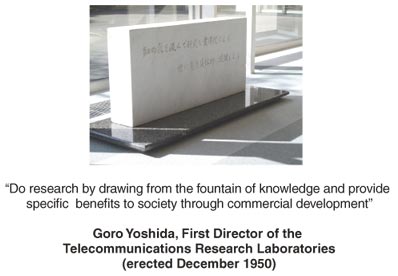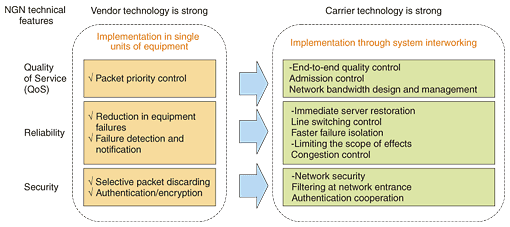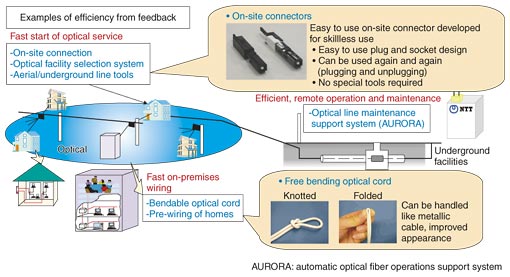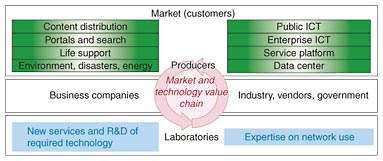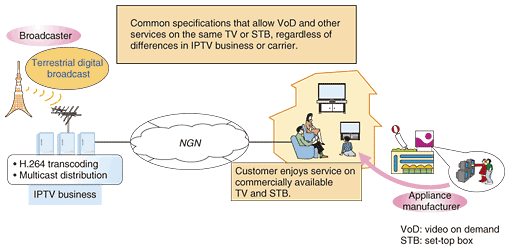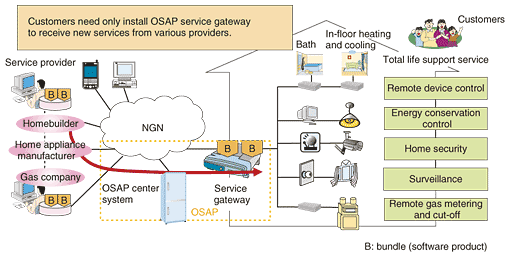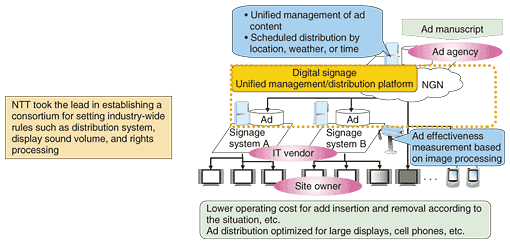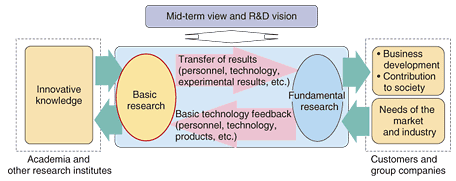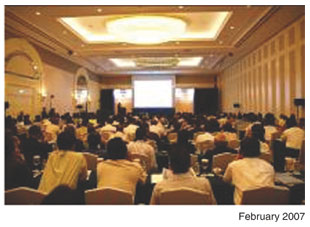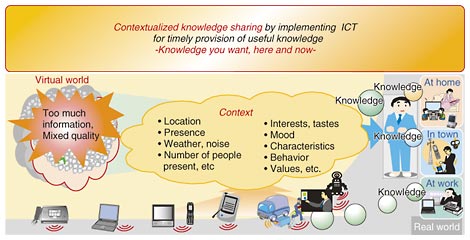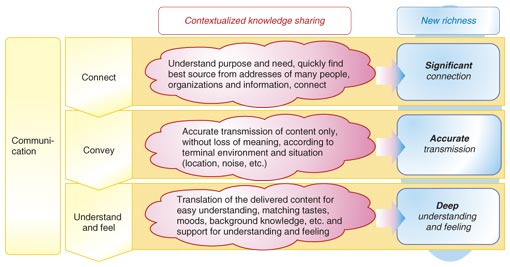 |
|||||||||||||||||||
|
|
|||||||||||||||||||
|
Special Feature: Keynote Speeches at NTT R&D Forum 2008 Vol. 6, No. 4, pp. 12–21, Apr. 2008. https://doi.org/10.53829/ntr200804sf2 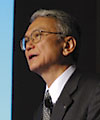 R&D for the Future of CommunicationAbstractNTT R&D is rising to the challenge of developing advanced technology that will open up a new future for communication while preserving the philosophy of practical research through technical innovation to achieve a prosperous and vigorous society that respects the global environment. This article is based on the speech given by Takashi Hanazawa, Senior Vice President and Senior Executive Director of the Research and Development Planning Department, at the NTT R&D Forum 2008, which was held on February 7 and 8. 1. NTT R&D environment and undertakingsIn this article, I will reaffirm the role of NTT R&D in light of the pervasiveness of the Internet in society and industry and various opinions about NTT R&D. I will also describe our efforts to contribute to business development and to social, industrial, and educational activities and will explain our course into the future. 1.1 Philosophy of NTT R&DThe two basic ideas of NTT R&D are to contribute to the sustainable growth of NTT Group business through excellent advanced technology and to contribute to the development of society, industry, and academia by occupying a prestigious position in the fields of science and technology. Laboratories cannot exist without the support of top-level management philosophy. Our philosophy is rooted in the establishment of the Electrical Communication Laboratory, the predecessor of NTT R&D Laboratories. The Telecommunication Research Laboratory of the Ministry of Communications was founded on August 1, 1948. The significance of that event and the 15-year history of the Electrical Communication Laboratory was expressed by Goro Yoshida, the first Director of the Laboratory, as follows. “This new laboratory was established for the main purpose of testing related to telecommunications, but it was in essence an entirely new thing. It became a central organization for communication business entities, for performing research and practical development to meet the needs of telecommunications enterprises, and for providing the technical support that businesses required. Needless to say, that research and development covered a wide range, extending from basic research on methods, equipment, devices, and materials to practical products.” Thus, the founding of the Electrical Communication Laboratory has been described as a transformation from the Electrotechnical Laboratory of the Ministry of Communications, an academically oriented institution, to a laboratory oriented toward producing practical results. In December 1950, when the dispersed laboratories were brought together at Musashino, that idea was carved into a monument as “Do research by drawing from the fountain of knowledge and provide specific benefits to society through commercial development.” (Fig. 1). This monument now sits on the first floor of the main building of the Musashino R&D Center. There has been a change in generation since then, however. Nippon Telegraph and Telephone Public Corporation became NTT, and it has become necessary to clarify the meaning of “to society” in light of the reorganizations.
The first of the two ideas mentioned above—contribute to the sustainable growth of NTT Group business through excellent advanced technology—is our mission. The second—contribute to the development of society, industry, and academia by occupying a prestigious position in the fields of science and technology—is, I believe, a social responsibility that originates from our background. 1.2 Recent changes in the R&D environmentThe environment in which NTT R&D operates has changed over the last several years, but the biggest environmental change has been how the Internet has become pervasive in society and industry. The three main changes relevant to NTT R&D that stem from the spreading use of the Internet are described below. (1) Internet and telecommunications technologies have converged and become generic It has become possible to use general-purpose products to construct networks instead of using proprietary telecommunications technology. The move toward software control and digitization had begun even before the Internet, but the Internet accelerated that movement. (2) Diversification and globalization of competition Competition from businesses other than telecommunications companies and the appearance of new competitors from outside the country have complicated the nature of competition. There has been a shift in the telecommunications industry itself toward higher-layer services as the infrastructure becomes commoditized, Skype and other such Internet technologies are being used to implement the same services as those provided by telecommunications companies and flat-rate charges are being introduced. (3) Market-driven standardization The de facto standards of IETF (Internet Engineering Task Force) and similar organizations are taking precedence over the de jure standards of organizations such ITU-T (International Telecommunication Union Telecommunication Standardization Sector). The process for setting standards is changing from discussion and decision-making in conferences of national representatives to activities in which an industry turns products or specifications used by customers into the effective standard. 1.3 Contribution of carrier R&D to businessNTT's R&D activities for contributing to business are broadly divided into the four tasks of (1) giving the network more advanced functions and making it more economical, (2) cultivating new services that use the network, (3) creating new markets and business, and (4) providing technical support to the NTT Group. (1) Making networks more advanced and economical A network that spans the entire country to serve as a social infrastructure and is safe, secure, and efficiently constructed and operated over the long term cannot be achieved just by introducing commercial products: it is absolutely essential to ensure the interworking of diverse systems, ensure freedom in the choice of equipment suppliers, improve operating efficiency, and so on. I believe that we must continue as expected with the duties outlined below to achieve, as a carrier, a network that is more advanced and more economical. (1-1) Overall optimization of networks Overall network optimization requires the integration of vendor technology and carrier technology. Functions that can be implemented in single units of equipment are handled well by vendor technology, but NTT R&D is undertaking research and development of overall optimization through the interworking of multiple systems. For example, NTT R&D achievements include technology such as end-to-end quality of service and congestion control, which supports network design and administration and is required in order to provide highly reliable and highly secure network services in the Next Generation Network (NGN) (Fig. 2).
(1-2) Avoidance of excessive reliance of a particular vendor For a carrier, having only one vendor for a key product poses a high risk, such as high prices resulting from the absence of competition and sudden unavailability caused by the supplying vendor withdrawing from the market. For that reason, incorporating diverse vendor technology into the network is a general principle for avoiding excessive reliance on the technology of particular vendors by moving toward a general multivendor policy of acquiring off-the-shelf hardware (black boxes). Moreover, for flexible and rapid addition or changes to the services menu or operation functions, it is a general principle that software should be developed within the Group in white box fashion because of the need to guarantee specifications and the means of implementation. NTT R&D helps to prevent excessive reliance on particular vendors by setting and performing comprehensive verification of hardware and software specifications, including the investigation of architecture and implementation methods, in a multivendor environment. (1-3) Feedback from operational experience By developing technology from the viewpoint of an operator (line installation, testing, and monitoring, etc.) and making use of expertise accumulated over many years of network maintenance and administration, we have aimed for innovation in terms of cost and speed in network construction and maintenance. For example, we have contributed greatly to reducing the cost of network maintenance work as well as the cost of cables and transmission equipment. As an example, the introduction of optical fiber into the access network is shown in Fig. 3. Connecting optical fibers used to require high accuracy from skilled workers, but we have developed connector technology that allows easy on-site connection of fiber ends. We have also developed bendable cable that facilitates the handling of optical fiber cable within the home [1].
(2) Pioneering new services that use networks To put new services into practical form promptly by using NTT advanced networks requires social pump priming to create new ways of using networks. It is also necessary to promote the widespread use of services by either opening up the technology used by the service or providing it as platform technology. NTT must develop business for the services that use the technology being developed by NTT R&D in the background. I believe it is also necessary to have NTT R&D Producers [2]. The work of a Producer is to foster business by diverse means such as product out, market in, market out, taking into consideration on-the-market technology as well as the technology developed by NTT itself. The Producer creates new services and business while coordinating with related industries, the government, and the customer base directly, as well as with business enterprises (Fig. 4).
We are also engaging in alliance activities for cooperating with partners to turn research results into business and forming alliances even at the basic research stage as part of the Producer activities. Eradicating the idea of produce it ourselves, we promote efficiency in research and development and the development of business from research results with the two approaches of join with partners that are appropriate to the objectives and seek alliances starting from relationships with given partners. (2-1) Producer activities for IPTV Concerning retransmission of terrestrial digital broadcasting by IP (Internet protocol), as one of the IPTV services, NTT R&D has established multicast distribution technology and H.264 transcoding technology in response to strict broadcaster conditions for the beginning of IP retransmission services for terrestrial digital broadcasting, which mainly concern the reproduction of broadcast quality and retransmission delay for an IP network. The Producer, together with broadcasters, home electronics manufacturers, and other carriers, promotes national and international standardization of technical requirements and operating rules while considering convenience for the user and the situation of content producers and rights holders. The result will be an environment in which customers can receive audio-visual services, including video-on-demand and other such services, with the same TVs and set-top boxes that are sold on the market, regardless of differences among IPTV businesses and carriers (Fig. 5).
(2-2) OSAP Producer activities NTT R&D has developed the highly general services platform technology (OSAP: OSGi (Open Service Gateway Initiative) Service Aggregation Platform) [3] for connecting home appliances that have diverse interfaces to a network. The Producer is involved in creating business by providing comprehensive life support services that can use OSAP technology to remotely control various appliances in the home. Having to provide appliance control equipment for each individual service results in a high cost for both customers and service providers. OSAP technology provides a common platform that allows all home appliances to be controlled through a single service gateway (Fig. 6).
The Producer is promoting an alliance of companies in different industries, such as homebuilders, home appliance manufacturers, and gas companies, to implement such comprehensive life support services. In addition to in-home services, coordination from a neutral standpoint is important to promote diverse services, for example, in-vehicle services, on a common platform. We at NTT are in a position from which it is relatively easy to make such proposals, and we intend to coordinate the opinions of concerned parties. Settling on this common platform involves advanced service platform technology, so R&D is contributing to technological development, technical standardization, and generalization in addition to the Producer activities. (2-3) Producer activities for digital signage NTT R&D thinks that outdoor displays will evolve into a new style of advertising and is developing technologies for centralized management of content and advertisements that will be distributed to multiple displays of different types over the network. It is also investigating ways to measure the effectiveness of such advertising. To increase the value of such displays, which are known in the trade as digital signage media, the Producer felt the need to solve the various problems systematically rather than by individual companies. He called for the establishment of a digital signage consortium that could serve as a forum for identifying the common problems and studying their solutions. Such a consortium was established in June 2007. As of February 2008, it had been endorsed by 51 advertising agents, site owners, display manufacturers, IT (information technology) vendors, and carriers. Its activities include the establishment of common technical guidelines for distribution and terminals, common media indices, and increased recognition by advertising sponsors. NTT R&D will continue to develop a platform that can provide cost advantages to service businesses and convenience to customers by allowing the presentation of appealing advertising as digital signage in various places. It will also propose specific types of business for it (Fig. 7).
(3) Creating new markets and business For sustainable growth of the NTT Group, we create new fields of business around the most advanced technology produced by NTT R&D. For example, we took the wavelength conversion technology and semiconductor laser technology that was developed for optical communication and applied it to the visible light spectrum to make a fluorescence microscope. And concerning the beam-steering characteristics of KTN crystals [4], [5], we are promoting their application to a wide range of industrial fields besides communications, including ones that use visible light. (4) Providing technical support to NTT Group business We use the excellent research environment and research resources of NTT R&D to support the business activities of the NTT Group. Through the accumulation of expertise in NTT R&D, we aim to avoid duplication of effort by individual NTT business companies and thus raise the productivity of the entire group and get feedback for research activities. The OSS Center conducts activities to support the development of systems that use open source software into efficient businesses, thus strengthening the total solutions provided by corporate services and reducing the total cost of a system within a company [6]. The Computer Security Incident Response and Readiness Coordination Team (NTT-CERT) [7] makes use of NTT R&D's technological strength to contribute to efforts to protect the personal information of customers and ensure the continuance of the company's business by strengthening cooperation with persons working on the security of the NTT Group. 1.4 Technological innovation through basic researchBasic research is undertaken continuously with strategic selection of fields of study. That allows us to contribute to business with certainty and a long-term vision. For example, the network being provided by the NTT Group is supported by the most advanced technology of its time, including optical devices, optical fiber, and encoding technology. It has also been operated with high reliability and security. This closeness to business also means that feedback from the business field allows basic research to be conducted with the objectives of sowing and nourishing seeds for subsequent generations, rather than simply as an academic quest. The innovation required for future communications needs a steady accumulation of basic research, feedback from the market, and fundamental technology cultivated over many years fused with practical expertise (Fig. 8).
1.4.1 Heritage of optical infrastructure technologyWe have implemented optical broadband services with more than 30 years of accumulated NTT research and development of optical fiber, optical splitters, optical access systems, wavelength division multiplexing transmission systems, and optical connectors. For example, in the optical access area, we implemented a PLC optical splitter based on planar lightwave circuits in 1986, a CATV (cable television) video transmission system in 1997, and the B FLET'S services with GE-PON (gigabit Ethernet passive optical network) in 2005. For the future, we continue with research toward network innovation such as the all-optical network and optical packet routers through technology such as photonic crystals, optical memory, and fast and highly stable variable-wavelength light sources. 1.4.2 Heritage of encryption technologyCryptosystem research concerns elemental technology that is important for supporting safe and secure network operation. We have been doing research and development that extends from fundamental theoretical work to practical methods and equipment continuously for more than 20 years. Our results include the Camellia cryptosystem [8], which is used in various products and has been adopted in national and international standard specifications and the open source community. 1.4.3 Heritage of quantum information technologyMaking use of our technology and expertise accumulated from materials and basic research, we have developed quantum information technology based on optical measurement technology, material science, and nanotechnology. We have expanded basic research towards achieving quantum cryptography, which achieves absolutely secure data transmission in which eavesdropping and falsification are impossible, and quantum computers, which have a higher order of computing power than current supercomputers. We have accumulated technology without interruption for over 20 years. 1.5 Contributing to and cooperating with industry, academia, and the governmentWe contribute to academic and industrial fields by cooperating with academia and the government utilizing their respective strengths and through friendly competition. At one time, it was thought that there was a separation of roles in which universities and public research organizations did basic research and corporations did applied research, but I believe that there is now less concern for such a division. An example of cooperation is participation in the New Generation Network Promotion Forum with the aim of creating a world-leading next-generation network developed in Japan in order to develop a network architecture and fundamental technology and achieve international standardization with the cooperation of industry, academia, and the government. We are also strengthening cooperation with universities. We are endeavoring to move away from the previous one-to-one relationships between individual university professors and NTT researchers and toward an organization-to-organization type of cooperation aimed at mutual benefit. 1.6 Global deployment of R&D achievementsWith respect to globalization, let me explain our efforts concerning the use of R&D results in other countries. 1.6.1 Promotion of international standardization activitiesWe dispatch key members to contribute to Recommendations and promote activities that involve domestic vendors, by participating in the CJK Meeting on Information and Telecommunication Standards* to strengthen cooperation among China, Japan, and Korea and invigorate standardization in the Asian region. Moreover, we are taking a leading role in domestic and international standardization activities by participating in the meetings of ITU, IETF, and other such organizations concerned with de jure and de facto standardization and submitting contributed articles (Photo 1). We also identify organizations that are engaged in highly influential discussions and actively participate in forums that are effectively setting standards.
1.6.2 Approach to other countriesWe are taking up the challenge of developing products available in other countries by facilitating customization to local characteristics, for example, and promoting cooperation with vendors. The optical fiber and optical connectors, video codecs, and other component-level technology that has been developed by NTT R&D has already spread globally, but we are also pushing for expanded use of advanced technology such as optical access (GE-PON, etc.) in communication systems to overseas businesses. 1.6.3 Popularization of technology and formation of partnershipsBy accepting trainees in response to demands to raise the skill level of technicians in developing countries and conduct technical seminars in cooperation with governments and vendors, our aim is to spread the application of NGN and FTTH (fiber to the home) technology. We are contributing to TTC activities for developing and diffusing solutions-based systems that combine various standards to promote the diffusion of standardized technology that can be easily applied in developing countries (Photo 1).
1.7 R&D contribution to businessNTT R&D has an unbroken record of research and development of technology that meets the needs of the time. Our results have found many direct and indirect uses in a variety of fields and have been well worth the investment. Through attractive new services, sales expansion, cost reduction, and NTT brand elevation, we have contributed greatly to raising the value of the enterprise and to its continuous growth. 2. Mid- and long-term R&D vision of contextualized knowledge sharing and the future of communicationsAt NTT R&D Forum 2007, last year, we announced a shift from information sharing to the new R&D vision of contextualized knowledge sharing. This represents a medium-term direction for R&D to provide useful knowledge in a timely fashion by implementing information and communication technology for dealing with the surfeit of information and the intermixing of the good with the bad in the virtual information world. In other words, our goal is to provide the knowledge you want, here and now (Fig. 9). I believe that communication in terms of connect, convey, and understand and feel means achieving a new richness in significant connections, accurate transmission, and deep understanding and feeling through contextualized knowledge sharing (Fig. 10). While we can imagine various services in the future, we are still merely standing at the entrance. AT NTT R&D Forum 2008, we displayed the work we are now undertaking toward a new world of communication achieved by contextualized knowledge sharing.
3. Toward a new world of communication achieved by contextualized knowledge sharingIn this article, I have focused on describing the undertakings of NTT R&D, but R&D management also faces challenges concerning what must not be changed and what must be changed for agile adaptation to changes in the environment. These matters must be distinguished with high accuracy. The record says that “on August 2, 1948, the members of the Electrical Communication Laboratory were deeply moved by the inaugural speech made by Goro Yoshida, the Founding Director of the practical research laboratory, and the deeply significant opening ceremony ended in the midst of joy and aspiration.” We will continue to preserve this basic idea of the applied research laboratory. We will continue to rise to the challenge of developing advanced technology for pioneering future communications and contribute to the achievement of a prosperous and vigorous society that respects the environment. References
|
|||||||||||||||||||








